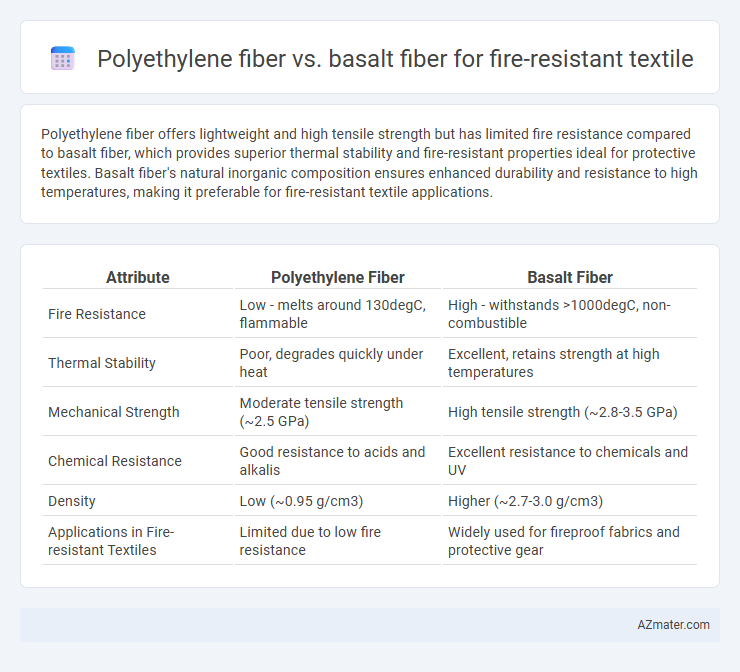Polyethylene fiber offers lightweight and high tensile strength but has limited fire resistance compared to basalt fiber, which provides superior thermal stability and fire-resistant properties ideal for protective textiles. Basalt fiber's natural inorganic composition ensures enhanced durability and resistance to high temperatures, making it preferable for fire-resistant textile applications.
Table of Comparison
| Attribute | Polyethylene Fiber | Basalt Fiber |
|---|---|---|
| Fire Resistance | Low - melts around 130degC, flammable | High - withstands >1000degC, non-combustible |
| Thermal Stability | Poor, degrades quickly under heat | Excellent, retains strength at high temperatures |
| Mechanical Strength | Moderate tensile strength (~2.5 GPa) | High tensile strength (~2.8-3.5 GPa) |
| Chemical Resistance | Good resistance to acids and alkalis | Excellent resistance to chemicals and UV |
| Density | Low (~0.95 g/cm3) | Higher (~2.7-3.0 g/cm3) |
| Applications in Fire-resistant Textiles | Limited due to low fire resistance | Widely used for fireproof fabrics and protective gear |
Introduction to Fire-Resistant Textiles
Fire-resistant textiles often utilize advanced fibers like polyethylene and basalt to enhance safety and durability under high temperatures. Polyethylene fibers offer lightweight properties and excellent flame resistance due to their low thermal conductivity and high melting point around 130-140degC. Basalt fibers, derived from volcanic rock, provide superior thermal stability, withstanding temperatures up to 650degC, making them ideal for applications requiring robust fire-resistant performance.
Overview of Polyethylene Fiber
Polyethylene fiber, especially ultra-high-molecular-weight polyethylene (UHMWPE), offers exceptional strength-to-weight ratio and excellent chemical resistance, making it valuable in fire-resistant textiles. Its low thermal conductivity and melting point around 130-136degC require it to be blended or treated for enhanced heat resistance compared to basalt fiber, which naturally withstands higher temperatures due to its mineral composition. Despite lower inherent fire resistance, polyethylene fiber's durability and flexibility contribute to advanced composite fabrics in protective clothing and industrial applications.
Overview of Basalt Fiber
Basalt fiber, derived from natural volcanic rock, offers exceptional fire resistance and thermal stability compared to polyethylene fiber, which has lower melting points and flammability. Its inherent high tensile strength, chemical resistance, and non-toxic nature make basalt fiber an ideal choice for fire-resistant textiles in demanding environments. Basalt fiber's superior heat resistance, withstanding temperatures up to 650degC, ensures prolonged durability and safety in protective clothing and industrial applications.
Thermal Properties Comparison
Basalt fiber exhibits superior thermal stability with a decomposition temperature above 815degC, significantly outperforming polyethylene fiber, which typically degrades around 150-160degC. Basalt fiber maintains mechanical properties at elevated temperatures and resists flame, making it ideal for fire-resistant textiles. In contrast, polyethylene fiber has lower melting points (approximately 130degC) and limited thermal resistance, restricting its application in high-temperature environments.
Fire Resistance Capabilities
Polyethylene fiber exhibits lower fire resistance capabilities due to its low melting point and tendency to melt and drip under high temperatures, limiting its effectiveness in fire-resistant textiles. Basalt fiber, derived from volcanic rock, offers superior fire resistance withstanding temperatures above 1000degC without melting or releasing toxic fumes, making it highly suitable for fire-resistant textile applications. The inherent thermal stability and non-combustible nature of basalt fiber significantly enhance the protective performance of fire-resistant fabrics compared to polyethylene fiber.
Mechanical Strength and Durability
Basalt fiber exhibits superior mechanical strength compared to polyethylene fiber, with tensile strength often exceeding 2,800 MPa, enhancing fire-resistant textile performance under high-stress conditions. Basalt fibers maintain durability and structural integrity at elevated temperatures above 600degC, while polyethylene fibers degrade rapidly around 150degC, limiting their application in fire-resistant textiles. The inherent thermal stability and abrasion resistance of basalt fiber contribute to prolonged lifespan and reliability in fire-retardant environments.
Chemical Resistance Performance
Polyethylene fiber exhibits excellent chemical resistance against acids, alkalis, and solvents, maintaining structural integrity under harsh chemical exposure, making it suitable for fire-resistant textiles in corrosive environments. Basalt fiber offers superior chemical stability, especially against acidic and alkaline substances, due to its natural volcanic rock composition, enhancing durability in fire-resistant fabrics exposed to aggressive chemicals. Comparing both, basalt fiber generally provides enhanced chemical resistance performance, particularly in high-temperature and chemically aggressive conditions relevant to fire-resistant textile applications.
Applications in Fire-Resistant Textiles
Polyethylene fiber offers excellent fire resistance and low smoke emission, making it ideal for lightweight fire-resistant clothing in industrial and firefighter applications. Basalt fiber exhibits superior thermal stability and maintains structural integrity at high temperatures, which suits heavy-duty fire blankets and insulation textiles. Both fibers enhance fire safety, but basalt fiber is preferred for extreme heat environments due to its higher thermal endurance and non-combustible nature.
Environmental Impact and Sustainability
Polyethylene fiber, often derived from non-renewable petrochemical sources, poses environmental challenges due to its lower biodegradability and higher carbon footprint compared to basalt fiber, which is produced from abundant natural volcanic rock with minimal processing emissions. Basalt fiber's inherent fire resistance, recyclability, and non-toxic nature contribute significantly to sustainable textile applications, reducing hazardous waste and environmental pollution. The durable nature and energy-efficient production of basalt fiber enhance its appeal as an eco-friendly alternative to polyethylene fiber in fire-resistant textile manufacturing.
Cost Analysis and Market Availability
Polyethylene fiber offers lower cost and wide market availability, making it a budget-friendly option for fire-resistant textiles, but its thermal stability is limited compared to basalt fiber. Basalt fiber, though more expensive due to complex manufacturing and limited production scale, provides superior fire resistance and durability, appealing to high-performance textile markets. Market trends indicate polyethylene dominates in mass-market applications, while basalt fiber gains niche adoption in specialized sectors requiring enhanced fire safety.

Infographic: Polyethylene fiber vs Basalt fiber for Fire-resistant textile
 azmater.com
azmater.com